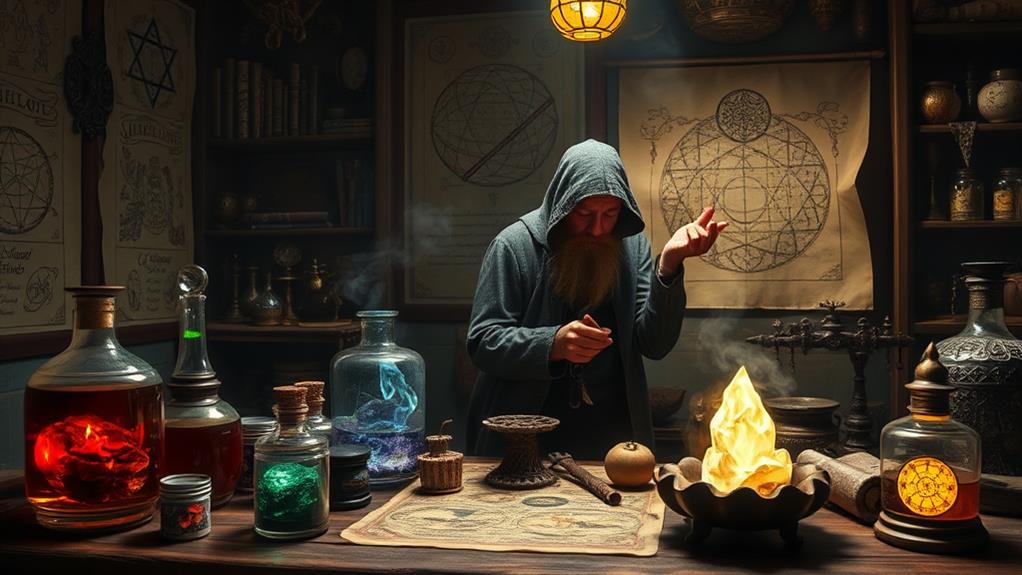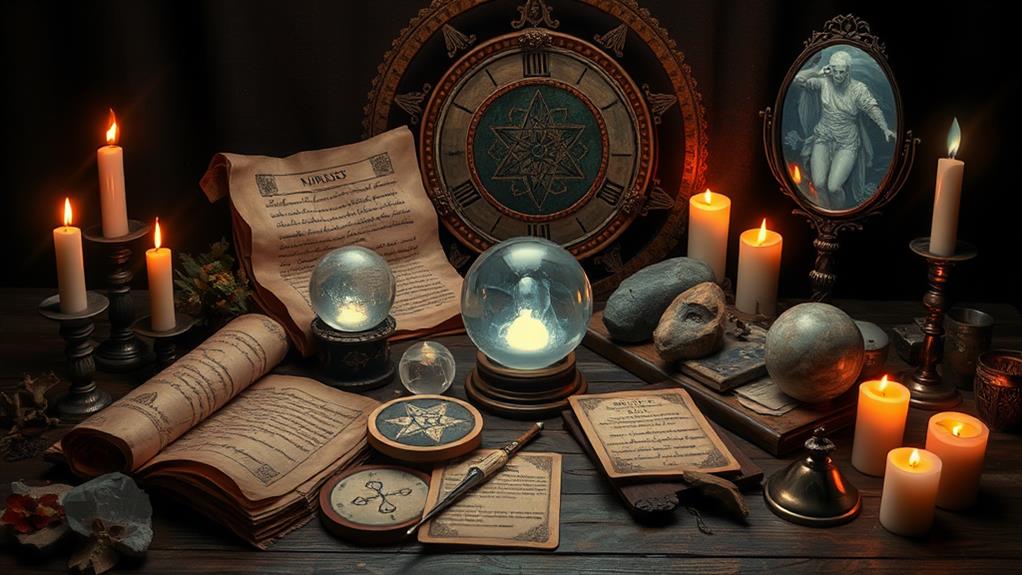
You'll find that magical theories and practices like alchemy, rune magic, and elemental magic each offer unique ways to tap into mystical energies. Alchemy seeks to transform both materials and the self, while elemental magic harnesses the core forces of nature. Divination and scrying, including tarot and astrology, provide insights into life's mysteries. Necromancy and summoning call upon spirits or entities to aid in various tasks. Enchantment focuses on infusing objects with magical properties, and transfiguration alters their very essence. Herbalism leverages plants' healing properties, and rune magic uncovers ancient symbols' power. Each practice enriches your understanding of mystical arts. These mystical arts often intersect, allowing practitioners to blend techniques for greater effect, such as combining herbalism with enchantment to craft potent healing amulets. For those delving into more specialized realms, magical beast care tips can prove invaluable, ensuring harmony between magical creatures and their caretakers. Through these diverse practices, the world of magic becomes a boundless field of exploration and discovery.
Alchemy

Alchemy, often seen as the precursor to modern chemistry, encompasses an ancient practice that sought to transform base metals into noble ones, primarily gold. You'd find that alchemists weren't just after material wealth; they aimed for spiritual enlightenment and the discovery of the philosopher's stone, believed to grant immortality.
In your exploration of alchemy, you'll learn it was divided into two main pursuits: the practical and the spiritual. Practical alchemists focused on laboratory experiments, using early forms of chemical reactions to try and create gold. They laid the foundation for modern laboratory techniques, contributing to the development of metallurgy, medicine, and even pharmacology.
On the spiritual side, alchemy was about transformation of the self. Alchemists believed that by purifying metals, they could also purify their souls. This aspect of alchemy intersects with various mystical and religious traditions, emphasizing inner growth and enlightenment.
You'll notice that alchemical texts are often cryptic, filled with symbols and allegories. These writings weren't just for secrecy; they reflected the belief that true understanding required personal insight and spiritual readiness. Alchemy, with its blend of science and mysticism, offers a fascinating glimpse into human history and the quest for knowledge.
Elemental Magic
Just as alchemy blends scientific inquiry with spiritual aspirations, elemental magic harnesses the fundamental forces of nature to achieve both practical results and personal transformation. You engage with the primary elements—earth, air, fire, and water—each representing different energies and influences. Earth grounds you, offering stability and strength. Air brings clarity and communication. Fire ignites passion and transformation. Water nurtures intuition and emotional flow.
To practice elemental magic, you'll first need to attune yourself to these elements. Spend time in nature, meditating on each element's unique qualities. Create rituals that incorporate symbols, like stones for earth or candles for fire, to focus your intent. Visualization techniques can help you channel elemental energies effectively.
Understanding the balance between elements is vital. Too much fire might lead to impulsiveness, while an excess of water could cause emotional overwhelm. By recognizing these dynamics, you can achieve harmony and enhance your magical practices.
Elemental magic isn't just about casting spells; it's a way to connect deeply with the world around you. By doing so, you not only manifest desired outcomes but also cultivate inner growth and wisdom.
Divination

When it comes to divination, you're tapping into the mysteries of the universe to gain insight into the past, present, and future. This ancient practice involves various techniques, each offering unique perspectives and methods for uncovering hidden truths. Some of the most popular forms include tarot cards, astrology, and runes.
Common Divination Techniques
| Technique | Tools Required | Primary Focus |
|---|---|---|
| Tarot Cards | Tarot Deck | Personal Guidance |
| Astrology | Birth Chart, Planets | Life Path & Events |
| Runes | Rune Stones | Situational Insight |
Tarot cards use a deck of 78 cards, each bearing symbolic imagery. When you draw and interpret these cards, you can gain clarity on personal challenges and decisions. Astrology, on the other hand, relies on the positions of celestial bodies at the time of your birth. By analyzing your birth chart, you can uncover information about your personality and life's trajectory. Runes involve casting stones inscribed with ancient symbols. The way they fall can provide answers to specific questions or general life advice.
Incorporating divination into your life can offer profound insights and a deeper connection to the unseen forces that shape your destiny. Each method brings its own strengths, allowing you to choose the one that resonates most with you.
Necromancy
While divination seeks guidance from the universe, necromancy turns to the spirits of the dead for wisdom and power. You'll find that necromancy involves communicating with, summoning, or even controlling spirits to gain insight or achieve specific goals. It's a practice shrouded in mystery and often viewed with fear and suspicion due to its association with death and the unknown.
Practicing necromancy requires deep knowledge and respect for the boundaries between life and death. You'd typically begin by creating a sacred space, often at night or in places closely tied to death, like graveyards. Rituals may involve invoking specific spirits, using tools like candles, bones, or personal items of the deceased, and chanting incantations.
You'll need to approach necromancy with caution. Missteps can lead to unintended consequences, like angering spirits or attracting malevolent entities. Ethical considerations also come into play; ensuring you're not disturbing the dead or using their power for harmful purposes is vital.
Necromancy isn't just about dark magic or control. It can also be a way to seek closure, honor ancestors, or gain wisdom from those who've passed on. Understand its profound impact and wield it responsibly.
Enchantment

How does one harness the power of enchantment? First, you need to understand that enchantment revolves around infusing objects or people with magical energy. This practice can make items perform specific tasks or endow them with special properties. For instance, you might enchant a ring to grant invisibility or a sword to burst into flames upon command.
To start, gather the object you wish to enchant and focus your intent. Intent is vital; without it, the magic won't take hold. Next, you'll need a source of magical energy. This can come from within yourself, a magical artifact, or even natural elements like moonlight or a sacred spring. Channel this energy into the object while visualizing the desired outcome.
Incantations often play a role, serving as a conduit to direct the energy more precisely. Think of them as the programming language for your spell. The words need to be chosen carefully, as they shape the magic's effects. Finally, seal the enchantment with a gesture or ritual, like a wave of your hand or a drop of your blood.
With practice, you'll find that enchantment becomes a powerful tool in your magical repertoire.
Shape-shifting
Ever wondered what it feels like to transform into another being? Shape-shifting, a staple in many magical traditions, lets you experience just that. Unlike other practices, shape-shifting involves altering your physical form into an animal, another person, or even a mythical creature. This practice isn't just fantasy; it's rooted in folklore and has historical accounts across cultures.
To shape-shift, you generally need a deep understanding of the target form and often a specific ritual or spell. Some traditions require you to wear an amulet or use herbs to facilitate the transformation. The process can be instantaneous or gradual, depending on the method and skill level.
Shape-shifting provides unique advantages. Imagine gaining the agility of a cat, the strength of a bear, or the flight of an eagle. However, it's not without risks. Prolonged transformations can lead to losing your humanity or forgetting your original form. Ethical considerations also come into play, as assuming another's shape can invade their privacy or autonomy.
In essence, shape-shifting is a powerful yet complex practice. It offers incredible possibilities but demands caution, respect, and expertise to navigate its intricate nature safely.
Rune Magic

What secrets do ancient symbols hold? Rune magic, a practice steeped in mystery and tradition, offers you a glimpse into the potent energies of runes—symbols that have been used for divination, protection, and manifestation for centuries. Originating from the Norse and Germanic tribes, these runes aren't just letters but powerful tools imbued with magical properties.
When you engage with rune magic, you'll find that each rune has its own unique meaning and energy. For example, the rune Fehu symbolizes wealth and abundance, while Algiz represents protection. Understanding the runes' meanings allows you to harness their energies effectively.
Here's a quick guide to some common runes and their meanings:
| Rune | Meaning |
|---|---|
| Fehu | Wealth |
| Algiz | Protection |
| Ansuz | Communication |
| Gebo | Gift |
To practice rune magic, you might cast the runes, carve them into objects, or even meditate on their symbols. By doing so, you're tapping into an ancient wellspring of wisdom and power. Rune magic invites you to explore the depths of these symbols, revealing their secrets and aligning your intentions with their energy.
Herbalism
Herbalism, a practice that dates back thousands of years, taps into the natural healing properties of plants. You'll find that herbalism isn't just about treating ailments but also about embracing a holistic lifestyle. By understanding the unique benefits of different herbs, you can enhance your health and well-being in numerous ways.
- Identification: Learning to correctly identify plants in the wild is vital. Misidentifying a plant can lead to ineffective or even harmful results. Invest time in studying plant identification guides and perhaps even join a local herbalist group.
- Harvesting: Knowing when and how to harvest plants guarantees you get the most potent ingredients. Timing can affect the concentration of active compounds, so harvest herbs during their peak growing seasons for maximum benefit.
- Preparation: Herbs can be prepared in various forms such as teas, tinctures, and salves. Each method extracts different properties from the plant, so choose the preparation method that best suits your needs.
- Application: Whether you're using herbs for medicinal purposes or spiritual practices, understanding the correct dosage and application is essential. Always start with smaller doses to gauge your body's reaction.
Embrace herbalism, and you'll discover a natural path to wellness.
Summoning

While herbalism offers a grounded approach to harnessing nature's gifts, summoning brings an entirely different dimension to magical practice. When you summon, you call forth entities, energies, or even objects from other domains or locations. This practice isn't limited to calling spirits or demons; you might also summon elemental forces, animals, or celestial beings.
To successfully summon, you'll need to master a few key components: intention, focus, and ritual. Your intention must be crystal clear—know exactly what or who you're summoning and why. Focus is vital; any wavering thoughts might result in unintended consequences. Rituals, often involving incantations, sigils, or specific tools, serve to channel your energy and lend structure to your intentions.
Summoning can be incredibly rewarding but also risky. You should always take precautions, like casting protective circles or wards, to safeguard your safety. It's also wise to set clear boundaries with any summoned entities to prevent them from overstaying their welcome. Whether you're calling upon a guardian spirit for protection or seeking guidance from an ancient sage, summoning opens up a world of possibilities that transcend the physical limitations of our everyday existence.
Transfiguration
Transfiguration, a cornerstone of magical practice, allows you to alter the form or essence of an object, being, or even yourself. This powerful skill requires focus, precision, and a deep understanding of the properties of both the original and the desired forms. By mastering Transfiguration, you can achieve feats that range from the practical to the extraordinary.
Consider these four key aspects of Transfiguration:
- Object to Object: Transforming one inanimate object into another is often the first step in learning Transfiguration. For example, turning a quill into a goblet can be a useful party trick or serve practical purposes.
- Object to Animal: This advanced technique involves giving life to inanimate objects. Imagine transforming a broom into a bird, allowing it to fly away. It's not just magical but also highly complex.
- Animal to Animal: Changing one living creature into another, such as turning a mouse into a cat, demands a higher level of skill and concentration. It's often used for disguise or adaptation.
- Self-Transfiguration: The most challenging and dangerous form, allowing you to alter your own body. Whether it's changing your hair color or transforming into an entirely different species, this practice requires utmost caution and expertise.
Mastering these techniques opens up a world of endless possibilities in the magical domain.
At a Glance
Just like a chef blends various ingredients to create a perfect dish, mastering magical theories and practices requires a mix of knowledge and skill. Imagine an alchemist’s lab where each element, rune, and herb has its place, purpose, and power. By understanding and integrating these diverse magical disciplines, you can reveal a symphony of possibilities, crafting your own unique brand of magic. Remember, the magic lies not just in the practice but in the harmonious fusion of them all. In this enchanting journey, you’ll discover that just as recipes in the culinary world combine flavors to create a magical meal, so too can you weave together different magical meal recipes. Each experience, whether it’s studying ancient texts or experimenting with new incantations, enriches your understanding and expands your repertoire. Ultimately, the true essence of magic is found in the blend of tradition and innovation, allowing you to serve up spells that are as unique and delightful as a five-star feast.






